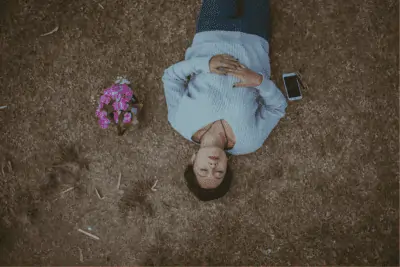What is the best sleeping position for health?
Maybe you’ve been told that there’s a trick to optimizing sleep based on how you lay, or that there’s a best sleeping position for health.
And the truth is, this does matter.
But this isn’t a one-position-fits-all situation.
There are a few different buckets of sleeping needs you could fall into that will help decide the best position for you.
Let’s get into it.
Should everyone sleep on their back?
The short answer: no.
In fact, that’s the first position I tell many people to avoid.
The average American probably has a little extra weight on their body and if you’re diagnosed with sleep apnea (or at risk of it due to that extra weight) sleeping on your back should be avoided.
This is because sleeping on your back can easily lead to strain on the airways that leads to snoring.
And while most of us think of snoring as a basic nuisance, it’s actually physically damaging and preventing certain parts of the sleep cycle from occurring.

What is snoring?
Now, why is snoring such a big deal?
Besides the other person you’re keeping awake from it, I mean.
Well, if you’ve got sleep apnea or some extra weight hanging around, there’s extra pressure being applied to your throat area when you lay on your back.
This means that the smooth muscle lining the breathing canal begins to collapse back.
When the smooth muscle has done that, it needs a little extra help to open up the breathing canal properly to continue bringing air to your lungs.
Since the smooth muscles isn’t nearly as strong as skeletal muscles, your body begins recruiting skeletal muscles to help open up the breathing passages enough.
The flapping sound of a snore is when all of this happens to accumulate into that first big inhale at the top of a snore.
And the problem for the snorer here is that the activation of skeletal muscle pulls you out of REM sleep.
During the REM phase of sleep, your skeletal muscles are paralyzed.
So, every time you snore, you’re pulling yourself out of possible REM sleep.
If this isn’t disruptive enough, you need to go through each stage of sleep to get to the next one.
You can’t just jump from stage 1 to stage 4 (for reference, REM is stage 2).
So, if you’re constantly snoring, you can’t just drop right back into where you left off.
Your body and brain need to go through the whole process of dropping into deeper sleep with each snoring cycle.
Not only are you annoying anyone sleeping near you, you’re quite literally cutting off your natural sleep cycles when you’re caught in a snoring cycle.
The tennis ball trick
So, how do you prevent yourself from sleeping on your back if snoring is your issue?
It’s a pretty simple trick, actually.
Take a tennis ball and tape it square between your shoulder blades.
That way, even once you’re asleep, your unconscious mind won’t want to move to your back, either.
It sounds ridiculous, but it works and can help you get your sleep cycles back fast…and your bedroom partners’, too!

If you’re not a snorer…
Orthopedically, sleeping on your back is one of the best positions.
Again, this is only the case if you’re not a snorer. That condition can change with age and weight, too.
So, believe people if they tell you you’re snoring and that hasn’t been the “norm” for you in the past.
But for those who really don’t snore, laying on your back makes a lot of sense.
It keeps your back closest to the spine’s natural curvature, allowing for the least amount of pressure on all of the joints.
So, if you have orthopedic problems, sleep on your back.
If you’re dealing with joint pain…
I just hit on this a little bit, but beyond just your sleep position, you really need to be willing to invest in a great mattress.
It might seem like too much of an expense, but when you think about it, there are two things in life worth spending a lot of money on:
- Your mattress.
- Your shoes.
Because if you’re not in one, you’re likely in the other.
And by the way – most of those mail-order foam mattresses aren’t as good as they try to lead you to believe.
They break down a lot in just a year or two, and they’ll be sagging before you know it.
A high-quality mattress will last you a lot longer than that, so you’ll be saving money in the long-term by investing once.

The best sleeping position
Now, we’ve talked about the best position for snoring and the best one for orthopedic issues.
However, I doubt you’ve heard much about this last position.
It’s called “semi-prone” and causes the least amount of pressure on the spine.
If you look at the photo above this paragraph, you’ll see what I mean.
It’s kind of a mix between stomach and side sleeping, and it’s one that I think a lot of people naturally fall into.
While sleeping on your back causes your spine to stay in its most “neutral” state, this one takes even more of the pressure off of it.
It’s a position like your upper body is on its side, with your lower body twisted so that your pelvis is more down on your stomach side.
And of course, it’s really comfortable! Which matters a lot, too.
So, there you have it.
I hope these positions and reasoning behind them help you to improve your sleep!
And, if your position isn’t the only thing keeping you awake at night, my non-addictive Sleep Remedy Supplement is available to help you fall and stay asleep better than ever.
Check it out right here:

